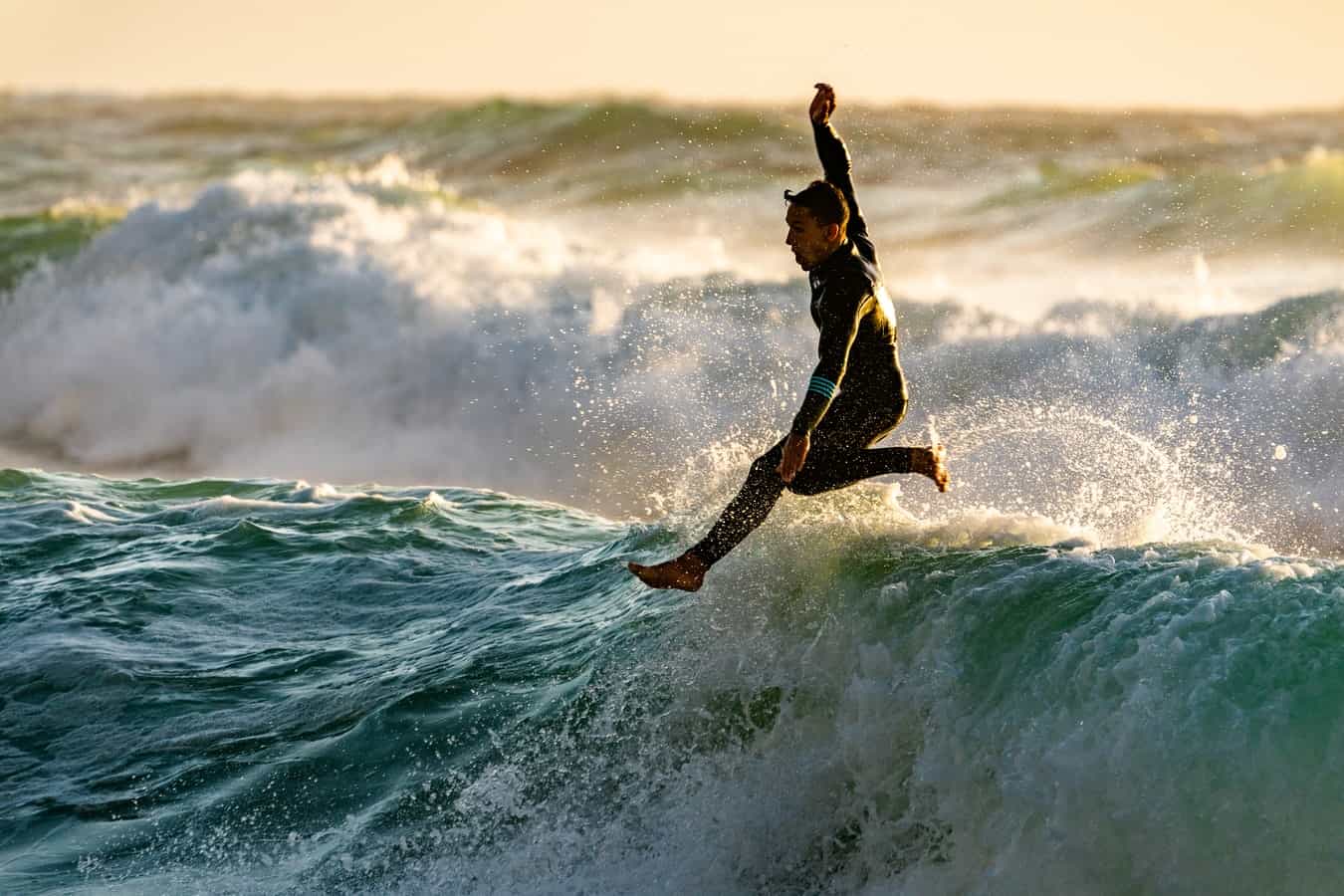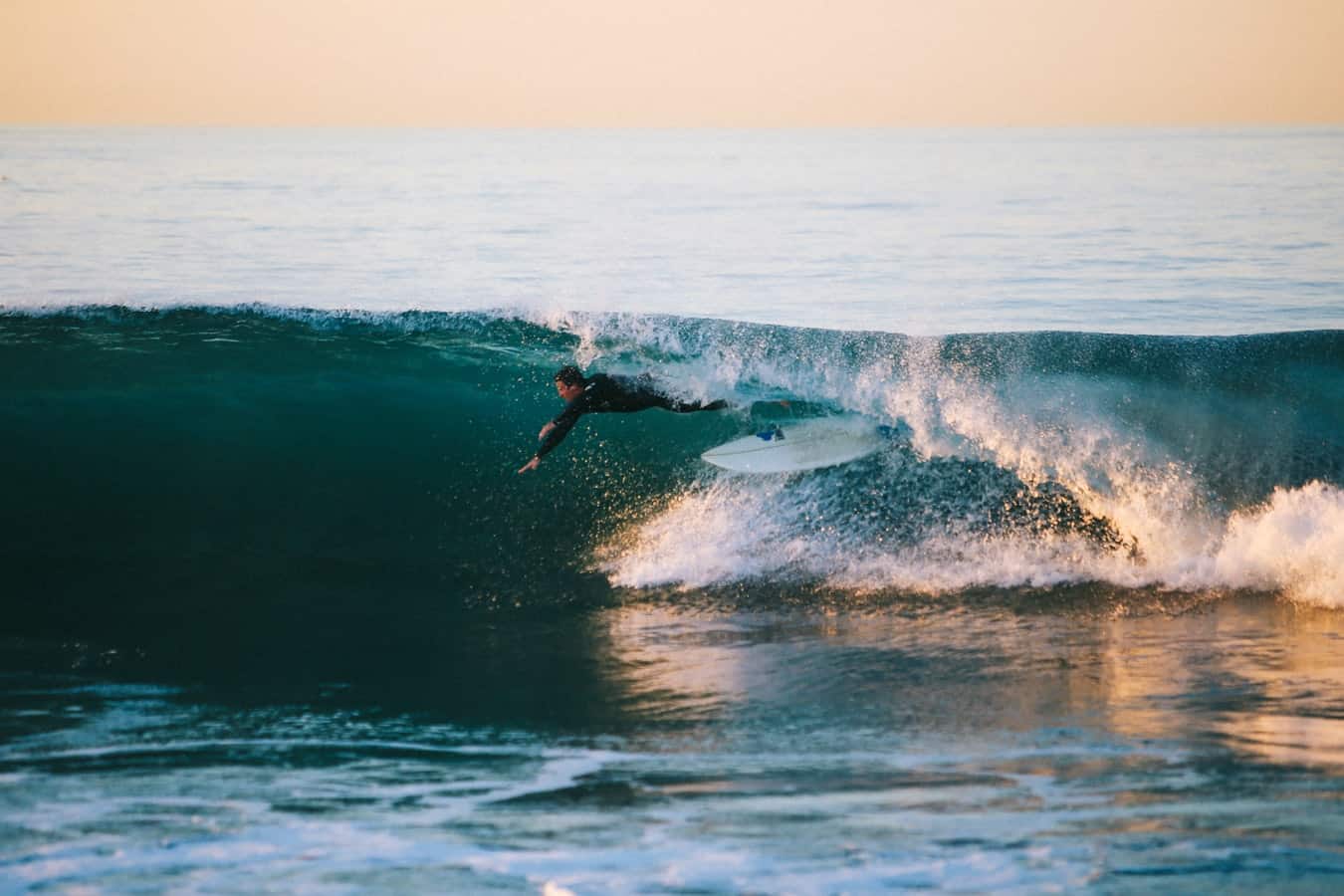Whether you are a beginner or an expert, falling off a surfboard is an inevitable part of the sport. Beginners often think that falling while surfing is a non-issue, after all you’re surrounded by water, right? However, falling improperly can result in injuries or damage to your board. It’s really important to fall properly! Personally, I’ve seen surfers crack their boards and badly bruise knees by falling on their boards. I decided it was important for me to find out how to fall of a surfboard.
What is the best way to fall off a surfboard properly? There are a few steps and tips that ensure you are properly falling off your surfboard. The number one tip is always to fall backwards, behind your surfboard.
More on the details of how to properly fall off your surfboard and the importance of falling properly later.
How Common it is to Fall off Your Surfboard?
It is extremely common to fall off your surfboard! If a surfer tells you they have never fallen off their surfboard, they’re surely lying. Every single surfer has fallen many times, especially while learning.
When I was learning to surf, the very first thing I learned was how to fall off my surfboard. I thought this was crazy… I thought “I don’t even know how to stand up on my board yet!?” However, my friends insisted that first and foremost it was important that I know how to properly fall off my board. Boy, were they correct. As soon as I got surfing, I was crashing left and right and falling all over the place. It didn’t bother me – in fact, it was really fun! When I was learning to surf, I got huge adrenaline rushes from standing up while catching a wave. Falling off didn’t bother me, it was simply an awesome splash into the beautiful ocean.
Once I got better at surfing, I quickly learned how important it was for me to have already “mastered” (if that’s even possible) how to properly fall off my surfboard. Now that I was catching bigger waves, the risk had increased and it was great that I was able to fall with ease in proper form, as it was ingrained into my muscle memory.
Common Injuries from Falling off Your Surfboard
Surfing is generally considered a pretty safe sport. Compared to high-contact and high impact sports like football or running, surfing typically has fewer injuries. However, being at the mercy of nature in the ocean does put surfers at a big risk. That being said, while there are usually fewer injuries in surfing, there is the capacity for serious injury. There are risks associated with just about every single thing we do. It’s important to continue doing what we love and just do it as safely as possible!
According to Surfer Today.com, “the most common consequences of falling off the surfboard are cracked surfboards, sprained ankles, ruptured eardrums, lacerations, muscle strains, broken noses and necks, and minor leg injuries. In the worst case scenario, you may drown.” They elaborate by saying, “surfers should be able to manage the risks involved in wave riding and prepare for extreme wipeouts. Fins and noses are sharp weapons and can quickly draw blood”. Obviously there is a wide range of possible injuries, and while surfing is generally a safe sport, it has it’s associated risks.
According to the inertia.com, “wiping out on the board and coming down extremely hard (especially onto rock, reef, or sand) on your back, head, or your butt can cause areas of the spinal cord to actually burst. Lesser degrees of trauma may cause transient symptoms. If you take a hard fall and later experience symptoms like numbness, tingling, headache, confusion, any alteration in the full use an extremity, dizziness, etc. head to the ER.”
According to Saltwater-Dreaming.com, “Falling towards the bottom, being held under for a long time, not knowing which way is up, broken boards, collisions with other surfers and various injuries, are some of the joys of surfing, but if you don’t know what to do it can be very traumatizing. Falling off on smaller waves, may not be too bad, but when the waves are big, it’s a different story.”
It’s at this point, that I want to reiterate how everything has it’s risks associated, and that it’s simply good to learn and practice smart risk management.

How To Correctly Fall off Your Surfboard
Don’t get down that you fall off your surfboard. Everyone does it, even the pros! What’s important is that you know how to fall off your surfboard.
First off, try to limit the amount that you fall off your surfboard. As stated, it’s impossible to entirely guarantee that you don’t fall off your surfboard. However, by surfing within your limits on boards that suits your level and on waves that suit your level, you will best limit the number of falls reduce the severity of your falls.
When you do fall, it’s important to stay calm and composed. Falling is no big deal! What’s important is that you fall safely. If you feel yourself about to fall, don’t jump or dive off. You don’t know what’s underneath you. I can’t imagine anything worse than diving into shallow coral. Just go with the water and let your fall happen. Saltwater-dreaming.com states “When you are getting a work-over from the wipe out, just relax, roll around and have fun. The wave will eventually let you go and then you can re-surface. If you fight against the wave, you are just using up oxygen and energy on a fight you will never win.”
Most importantly, when you fall off your surfboard, always try to fall backwards and away from your surfboard. Use your feet to push the surfboard away from you. Why? If you fall in front of the surfboard, it may be pushed on top of into you by the wave. A surfboard moving at full speed can really hurt if it bashes into you.
While you’re falling off your surfboard, fall onto your butt or feet. Be sure to bend your knees if you are falling feet first. Never fall headfirst! You don’t know how deep the water is or if there are any obstacles beneath you. Moreover, when you are falling, protect your head with your arms. Wrap your head in your arms to protect from the surfboard bashing you or from hitting an obstacle underwater.
When you are coming back to the surface after your fall, it’s important to maintain your cool and practice safety at every step of the way. It’s important to delay resurfacing. By delaying underwater, this gives the surfboard a chance to move on with the wave so that it does not come crashing down on your head when you surface. Moreover, when you are surfacing, make your way to the surface hand first. Since you don’t know where your surfboard is, it’s better to find out where it is with your hand than your head! This is particularly important because the fins on surfboards are very sharp and can slice your head if you were to come up into them.
Protective Gear to Wear While Surfing to Prevent Injuries From Falling off Your Board
Unfortunately, it’s not extremely common to wear protective padding while surfing. However, it is a great idea! It is a particularly great idea for beginner surfers, older surfers, or older surfers who have preexisting injuries or health conditions. First and foremost, if you wear braces (ankle braces, knee braces, shoulder braces, etc.) when you practice other sports, you should continue to wear these braces when you surf.
It is also a great idea to wear a helmet. It honestly boggles my mind that it’s not more common for people to wear helmets while surfing. In the recent past, it was standard practice for pro-surfers to wear helmets at competition! According to theintertia.com, “Top surfers like Tom Carroll or Gary Elkerton wore protective headgear either competing at Pipeline or free surfing at G-Land. Lately, it seems that very few surfers still wear a helmet, even in death-defying conditions. So why has the surf helmet dropped off the radar? Aren’t surfers aware of the risks of head injury? Or are they just too cool to wear a helmet?” I personally think it’s a great idea to wear helmets and other protective gear while surfing. Why not be as safe as possible? What’s more, according to theintertia.com, head trauma is a major cause of injury among surfers. “Our study about surfing-related accidents in the southwest France showed that 51% of injuries affected the surfer’s head (scalp or facial cuts, concussions, nasal fractures, dental traumas, perforated eardrums). Head trauma can be caused by contact with the sea floor, but most of the time, the mechanism for head injury is direct collision with a surfboard. Sharp fins and pointed noses are the most frequent causes of lacerations”. This is particularly relevant to injuries caused from falling off surfboards. There are specific helmets designed for surfers. A quick Google search will result in hundreds of surf-specific helmets.
Furthermore, as mentioned on another blog by this website answering the question “Can You Learn to Surf At Any Age?” there are two other primary protective padding items offered for surfers. The first is a vest. These vests pad the area where surfers’ ribs press against their surfboards while paddling and provide comfort for surfers who experience rib pain. The second common protective padding surfers wear are kneepads. These kneepads protect your knees from slamming on the hard board while you are standing up to catch a wave or when you fall from standing. All of these are great options for learning how to
Related Questions:
You Mentioned, “I Can Reduce Your Falls By Surfing On Boards That Suit My Level”. What do You Mean By That?
The better surfer you are, the smaller your surfboard can be. As mentioned on another blog by this website answering the question “Can You Learn to Surf At Any Age?”, generally speaking, the bigger the board, the better it is for beginners. The best boards for beginner surfers are funboards or longboards. A funboard is a surfboard that is six to eight feet long (pretty big!) and is wider than an average board. The large surface area on a funboard allows beginner surfers to practice finding the right stance. A longboard is similar to a funboard, but it is even longer and usually thicker (has extra foam). A longboard is a floatier and slower ride than other surfboards, and allows riders (beginner or experts) to move forward and backward on the board once standing.
How Do I Learn To Properly Fall off My Board?
There are many possible answers to this question. If you have surfer friends, ask them to help you out and give you live time pointers. If you don’t currently know anyone who is an experienced surfer, take a surf class! I also find it very helpful to watch YouTube videos demonstrating correct surf techniques and form. However, practice makes perfect. The more you surf, the better you get!
How Much Do Surf Lessons Usually Cost?
As mentioned on another post by this website, there is a wide price range for surf lessons. You can usually choose from group or private surf lessons. Private lessons are more expensive. Private surf lessons in the US usually cost somewhere between 20 – 150$ for a two hour session.

